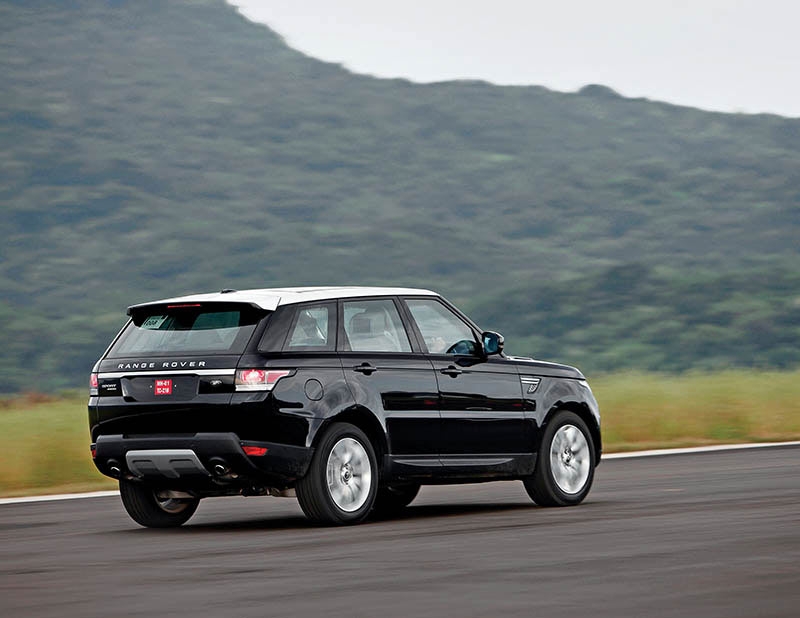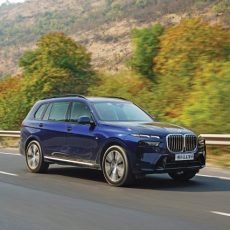The traditional ladder-on-frame gives way to a space-age aluminium monocoque that’s derived from the new Range Rover, but is, in fact, 75 per cent new. Comparatively the Sport is stiffer than the bigger Range Rover, as the engineers had to tune the suspension (double wishbone front, multi-link rear, with all round air springs) for crisper handling and better road dynamics. The Sport is lighter and more agile, at the same time is also more affordable than its bigger brother. I would have been sold on the Sport right there, but then its ride quality is rattlingly firm and allows way too much road undulations into the cabin, which just doesn’t match the plush ride of the Range Rover. On racetracks and occasional flat roads the Sport is brilliant considering its size, as the tall SUV does not show signs of pitching. But on the far-from-perfect regular city roads, where the car would spend most of its life, I desired the standard Adaptive Dynamics-equipped suspension to be more forgiving, at least in Comfort mode.
After negotiating through the excruciatingly congested city roads, we were off to the wide open highways. It’s time to get the Terrain Response into action mode. The HSE gets the basic Terrain Response as standard and the latest Terrain Response 2 comes with an optional ‘On/Off Road Pack’. If you’re willing to shell out extra, then the Pack will bring along the electronically controlled rear locking differential and torque vectoring technology as well.
 I reach for the Terrain Response dial and bypass off-road settings like mud and ruts and grass/gravel/snow and settle for the curvy road symbol of ‘Dynamic’ mode, which promises to squeeze out the maximum performance out of the V6. The system firms the dampers further, steering tuned to its sporty best and diverts additional torque from the front to the rear wheels. Though the difference in the suspension setting is not as pronounced, the car does tighten up and despite it being so tall, there is no trace of wallowing. Clearly, the Sport has been nurtured more for on-road dynamics and it’s here that it proves to be superior than the mighty Range Rover.
I reach for the Terrain Response dial and bypass off-road settings like mud and ruts and grass/gravel/snow and settle for the curvy road symbol of ‘Dynamic’ mode, which promises to squeeze out the maximum performance out of the V6. The system firms the dampers further, steering tuned to its sporty best and diverts additional torque from the front to the rear wheels. Though the difference in the suspension setting is not as pronounced, the car does tighten up and despite it being so tall, there is no trace of wallowing. Clearly, the Sport has been nurtured more for on-road dynamics and it’s here that it proves to be superior than the mighty Range Rover.
Throwing the Range Rover Sport around curvy tarmac is blissful, especially if you consider the bulk of metal you’re carrying along. The Adaptive Dynamics system firms up during cornering and eases off on the straights for agility without hampering the ride quality. There’s limited roll and stunning grip from the front, so you tend to push the car to its limit and get back on the accelerator faster as the torque-vectoring and anti-roll bar get busy to help the Sport power out of that bend maintaining the desired line by ironing out any understeer. The process seems so simple and effortless, but I’m sure many other SUVs would end up doing unwitting off-roading if they attempted to keep up with the Sport around turns. Even the electro-mechanical steering is pretty sorted. It’s quick, nicely weighted and quite accurate. It subtly throws road surface feedback back through the rack.
 The British marque also positions the Sport as a performance vehicle, which has almost everything to challenge most sporty sedans. To think of it, the Range Rover Sport has many things going for it. You’re sitting high with excellent visibility, you can depend on that firm suspension and chassis for great control, there is ample grip and excellent manoeuvrability. Unfortunately, the 3.0-litre diesel motor is just not quick enough. The naught to 100 km/h of 7.97 seconds or the quarter mile sprints in 15.75 seconds at 144.81 km/h are not really shattering figures. It takes 20 seconds to reach 160 km/h. The kick-down figures also signal at mid-range lacking the punch. The over two tonne weight also goes against the car. The eight-speed ‘box does its best by shifting rapidly between the ratios to keep you in the powerband, but then there’s not enough top-end to fall back upon either.
The British marque also positions the Sport as a performance vehicle, which has almost everything to challenge most sporty sedans. To think of it, the Range Rover Sport has many things going for it. You’re sitting high with excellent visibility, you can depend on that firm suspension and chassis for great control, there is ample grip and excellent manoeuvrability. Unfortunately, the 3.0-litre diesel motor is just not quick enough. The naught to 100 km/h of 7.97 seconds or the quarter mile sprints in 15.75 seconds at 144.81 km/h are not really shattering figures. It takes 20 seconds to reach 160 km/h. The kick-down figures also signal at mid-range lacking the punch. The over two tonne weight also goes against the car. The eight-speed ‘box does its best by shifting rapidly between the ratios to keep you in the powerband, but then there’s not enough top-end to fall back upon either.
The biggest drawback for the Range Rover Sport is its ultra premium price-tag. The basic SDV6 will set you back by Rs 1.10 crore (ex-showroom, Mumbai), which is about Rs 10 lakh more than a Porsche Cayenne S Diesel, powered by a more powerful V8. Yes, the Cayenne may not match the Sport’s off-roading capabilities, but can happily do more than what one would actually require. Having said that, there’s no denying that the Range Rover Sport is a well-finished product that balances on-road and off-road luxuriously well. But its firm ride quality doesn’t match Indian roads even if you are willing to pay the high price for exclusivity.
Clearly, the Sport has been nurtured more for on-road dynamics and it’s here that it proves to be superior than the mighty Range Rover
Story: Sarmad Kadiri
Photography: Sanjay Raikar





